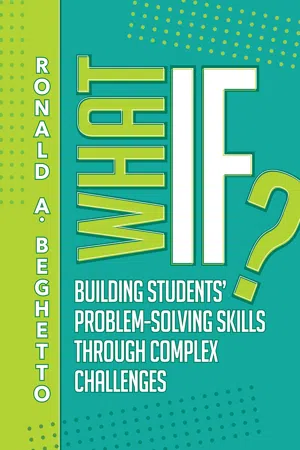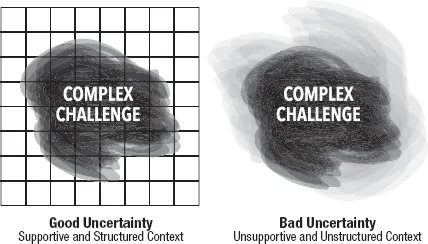![]()
Part 1
Challenges: From Simple to Complex
. . . . . . . . . . . . . . . . . . . .
![]()
Chapter 1
What Is a Challenge?
. . . . . . . . . . . . . . . . . . . .
What if there was a way to unleash your students' problem solving by using challenges to invite good uncertainty into your classroom?
A challenge literally means an invitation or a call to action. Challenges vary in scope and complexity. When you ask students to complete academic assignments or tasks, you are presenting them with classroom challenges, which can range from simple to complex. When you invite students to engage with larger problems facing them, their school, the community, or beyond in ways that require them to push their learning beyond the walls of the classroom, you are presenting them with beyond-classroom challenges, which are invariably complex.
Although classroom and beyond-classroom challenges differ in several key ways, they share the same basic structure. Understanding this structure will enable you and your students to identify the kinds of challenges you already use and prepare you to design and implement increasingly complex challenges.
The Basic Structure of Challenges
There are four basic features that all challenges share, regardless of whether they are simple or complex, classroom or beyond-classroom challenges. I like to envision this four-part structure as a puzzle (see Figure 1.1).
Figure 1.1. The Basic Structure of a Challenge
Here's a rundown of the four parts of this framework:
- The problem is the task, question, or issue students will address or solve.
- The process is the approach, method, or procedure students will use to solve the problem or complete the task.
- The product is the solution, outcome, or demonstration of solving the problem.
- The criteria are the guidelines, rules, and standards for evaluating success.
If you use this basic architecture as a lens for viewing your existing assignments and tasks, you will start to recognize how those assignments align with these four features and see differences between simpler and more complex challenges. For example, let's consider a routine assignment in language arts:
Read the assigned text and demonstrate your comprehension of the central ideas that the author is trying to communicate. Use the strategies that you were taught for identifying central ideas. Provide a written description of the central ideas and use descriptive examples from the text to justify your claims.
Figure 1.2 breaks down this assignment into the four core features of a challenge.
Figure 1.2. Example of a Simple Classroom Challenge
Note: This figure has been reformatted for more accessible reading in this e-book. View the original figure here.
Topic: Central ideas of a story
Subject area(s): Language arts
Full challenge statement:
Read the assigned text and demonstrate your comprehension of the central ideas that the author is trying to communicate [problem]. Use the strategies you were taught for identifying central ideas [process] (e.g., What is the topic? What does the title tell you? Which ideas in the introduction and conclusion seem to be most important? What clues can you find in the headings and subheadings?
What other hints do you see of the writer’s purpose, such as repeated ideas and comparisons with other topics and ideas? Can you quickly summarize the central ideas in a few words and provide a few brief examples, or do you feel like you are getting bogged down in too much general information?). Provide a written description of the central ideas [product] and use descriptive examples from the text to justify your claims [criteria].
Feature: Problem
Definition: The task, question, or issue students will address or solve
Description: Read the assigned text and demonstrate your comprehension of the central message of that text.
Feature: Process
Definition: The approach, strategies, or procedure students will use to solve the problem or complete the task
Description: Use the strategies you were taught.
Feature: Product
Definition: The solution, outcome, or demonstration of solving the problem
Description: Provide a written description of the central message.
Feature: Criteria
Definition: The guidelines, rules, and standards for evaluating success
Description: Use descriptive examples from the text to justify your claim.
Note that all the components of this challenge have been determined before it's been assigned to students. This would be considered a simple classroom challenge—not because it is necessarily easy for students to complete, but because the amount of uncertainty has been minimized. Remember: the more uncertainty students face, the more complex the challenge is.
Now, let's take a look at a complex beyond-classroom challenge. It represents an example of the legacy challenges introduced and discussed in Chapters 5 through 11:
A group of bilingual high school students recognize that Spanish-speaking members of their community are not receiving key health, educational, or community-based information. In response, they partner with local community agencies, businesses, and the school's Languages, Business, and Technology programs to develop a student-run translation service for members of the community. Students successfully maintain an operations plan (for running the service) and a succession plan (to pass the service on to incoming juniors and seniors) and provide timely and high-quality translation services to their community (as measured by satisfaction surveys).
Although this beyond-classroom challenge, broken down in Figure 1.3, is rather complex, it contains the same core features as the simpler language arts assignment.
Figure 1.3. Example of a Complex Beyond-Classroom Challenge
Note: This figure has been reformatted for more accessible reading in this e-book. View the original figure here.
Topic: Community translation service
Subject area(s): Spanish, entrepreneurship, web design
Full challenge statement:
A group of bilingual high school students recognize that Spanish-speaking members of their community are not receiving key health, educational, or community-based information [problem]. In response, they partner with local community agencies, businesses, and the school’s Languages, Business, and Technology programs to develop a student-run translation service [process] for members of the community [product]. Students successfully maintain an operations plan (for running the service) and a succession plan (to pass the service on to incoming juniors and seniors) and provide timely and high-quality translation services to their community (as measured by satisfaction surveys) [criteria].
Feature: Problem
Definition: The task, question, or issue students will address or solve
Description: Help members of the community who are not receiving key health, educational, or community-based information.
Feature: Process
Definition: The approach, method, or procedure students will use to solve the problem or complete the task
Description: Partner with local community agencies, businesses, and the school’s Languages, Business, and Technology programs to develop a student run translation service.
Feature: Product
Definition: The solution, outcome, or demonstration of solving the problem
Description: The student-run translation service ensures that key information is translated and made available to community members.
Feature: Criteria
Definition: The guidelines, rules, and standards for evaluating success
Description: Students successfully maintain an operations plan (for running the service) and a succession plan (to pass the service on to incoming juniors and seniors) and provide timely and high-quality translation services to their community (as measured by satisfaction surveys).
The key difference between these two challenges is the degree of uncertainty they present. The language arts challenge is a routine academic exercise (Robertson, 2017). All of its features are predetermined and designed without student input. Moreover, once students complete the assignment, the challenge is over. By contrast, the core components of the translation service challenge are not known in advance; students must face the uncertainty of identifying the problem and then developing a way to address it (Beghetto, 2017a). Even once completed, the challenge lives on in the form of a community-based translation service that is passed from one group of students to the next.
Note that both of these challenges are designed and implemented in the context of a structured and supportive learning environment. Providing this context is particularly important with more complex challenges. But how can teachers go about blending uncertainty with a supportive structure? The first step is to recognize that there are two types of uncertainty.
Good Versus Bad Uncertainty
In the context of the classroom, there is good uncertainty and there is bad uncertainty (Beghetto, 2016a). As Figure 1.4 illustrates, good uncertainty provides an opportunity to engage with an open-ended problem or a complex challenge in the context of a supportive and structured learning environment. By contrast, bad uncertainty emerges from learning experiences that confront students with uncertainty but fail to provide the necessary support and structure.
Figure 1.4. Good Uncertainty Versus Bad Uncertainty
Although complex challenges by design do not have predetermined procedures or outcomes, students still need guidance to navigate the uncertainty they face along the way. In situations creating bad uncertainty, students have no idea what is expected of them, how to get started, or whether, when, or how they will receive support. Asking students to tackle the uncertainties of complex challenges or open-ended problems in the context of an unstructured learning environment invites chaos into your classroom (Reeve, 2009), creating a double whammy of uncertainty that could easily overwhelm even the most accomplished problem solvers (Beghetto, 2017b). Fortunately, this need not be the case.
You can minimize bad uncertainty and maximize good uncertainty by presenting challenges in a supportive and structured environment. First, actively monitor how students are experiencing the challenges you have designed for them. In some cases, you may quickly recognize that students are experiencing bad uncertainty. Common signs include visible frustration, confusion, and misunderstanding (Gettinger & Kohler, 2006). You might, for instance, notice that the majority of your students are no longer paying attention or that even the students who typically engage with learning tasks are becoming frustrated and distracted and giving up. In such cases, it is important to …
- Stop. ("Let's stop for a moment.")
- Check in with students. ("I'm noticing that several of you seem frustrated or confused by this assignment.")
- Address the situation. ("Let's talk about what might not be clear or what seems confusing.")
Stopping in the middle of a lesson or an activity may seem awkward, but being able to spot and resolve bad uncertainty is crucial if we want students to successfully engage with complex challenges. Unless we provide students with the necessary support, they are unlikely to be willing to engage with more complex challenges, seek out assistance when necessary, or productively respond to the uncertainty they are facing.
In other cases, bad uncertainty may be more subtle and difficult to detect. Fortunately, simple formative assessment strategies (Wiliam, 2011) like entry/exit tickets and other brief check-ins can help you become aware of how students are experiencing the challenges you have designed and provide any needed supports. Figure 1.5 provides examples of before, during, and after check-ins that you can use.
Figure 1.5. Quick Cha...


